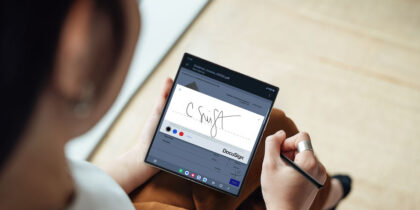Digital transformation has changed nearly every aspect of banking operations. However, there is one area where banks aren’t fully capitalizing on digital tools: the employee experience.
Branch employees still grapple with inefficient legacy systems, lack access to real-time customer insights and are often reliant on and thus tied to their desktops — all of which can prevent them from delivering the personalized service customers now expect. A recent IDC white paper sponsored by Samsung “Bridging the Digital-Human Gap: Strategies for Branches and Intermediaries – Insights from US Study on Modernization in Banking and Insurance1” found most banks aren’t providing employees with mobile tools that align with the changing nature of their work. Instead, they mainly offer laptops (99%) and desktop computers (90%) — two solutions actually limiting employee mobility within branches.
A better employee experience means a better customer experience. To accomplish this, banks must untether their employees and invest in flexible digital tools that boost their productivity.
Anywhere-anytime data access drives a better experience
The survey showed customers with more complex transactions prefer working with branch employees. Naturally, customers often turn to employees when seeking personalized financial guidance.
Technology that can move with employees, such as tablets, mobile devices and smartwatches, can help put the right information at their fingertips to address customer needs promptly — and IT decision makers and banking leaders realize this. Digital tools enhance productivity and efficiency, enabling branch employees to serve more clients effectively.
Bridging the digital-human gap in banking and insurance
Find out the expectations of banking and insurance customers in this IDC whitepaper sponsored by Samsung. Download Now
These digital tools allow employees to provide more convenient and impactful customer service, both online and offline. For example, they can use a secure tablet during off-site meetings with small business or corporate banking customers to walk them through financial products, such as specific loans or lines of credit, that might meet their financing needs. Within the branch, they can use the same device to streamline account openings, allowing customers to provide their information electronically and sign the necessary forms digitally.
When banks facilitate anywhere-anytime productivity in this way, they empower employees to serve their customers better.
Mobility enables secure, seamless access
Branch employees handle multiple daily tasks, including financial transactions, contract management, collaborating and communicating with colleagues, and engaging with customers. However, oftentimes, the tools supplied to them make juggling these tasks more cumbersome.
Many banks aren’t enabling employees with the devices they’re most comfortable using. For example, despite their organizations’ preference for laptops and desktops, most employees use handheld mobile devices to complete branch tasks. Only 12% of bank leaders surveyed said their organization has a bring your own device (BYOD) policy, while the remainder have adopted a choose your own device (CYOD) policy where employees pick from a predetermined product catalog. Security concerns are likely the main reason for this approach, as nearly 41% of leaders worry about the safety and privacy of client data on digital platforms.
However, banks don’t have to compromise security to enable their workforce digitally. They can embrace a mobile-first strategy while keeping their systems secure. Hardened, multifunctional, secure mobile devices allow employees to safely engage with colleagues and customers from anywhere. Banks can integrate wearable devices or smartwatches that provide real-time customer insights as employees move around the branch. Employees can connect to real-time collaboration and chat applications using these devices or tablets and communicate with colleagues in different parts of the office. With these tools, they can help a colleague answer investment-related questions as they serve a wealth management client. They can also direct a colleague to the required documentation for mortgage applications or even share marketing collateral on a new financial product their bank offers.
Improving staff mobility with secure digital tools can foster greater employee collaboration and knowledge-sharing and, in turn, support more seamless employee-customer interactions.
Empowering employees with better tech
As banks navigate the next digital transformation, flexible digital tools that empower employees will be vital to delivering a better customer experience.
Within branches, employees are an invaluable customer resource, but the meaningful in-person service they deliver doesn’t have to be analog. Put simply, digital technologies are what can enhance in-branch interactions. Banks must give employees modern tools that increase mobility and access to real-time, relevant customer information. Tablets, mobile devices and smartwatches should all be part of banks’ arsenal to serve their employees better and satisfy customers. By harnessing these solutions, banks can drive greater employee productivity and build a better, more customer-centric business.
To learn more about how banks are accelerating their digital transformation, download the white paper, “Bridging the Digital-Human Gap: Strategies for Branches and Intermediaries – Insights from US Study on Modernization in Banking and Insurance.”
1IDC White Paper, sponsored by Samsung, Bridging the Digital-Human Gap: Strategies for Branches and Intermediaries – Insights from US Study on Modernization in Banking and Insurance, #US52011624, May 2024.









